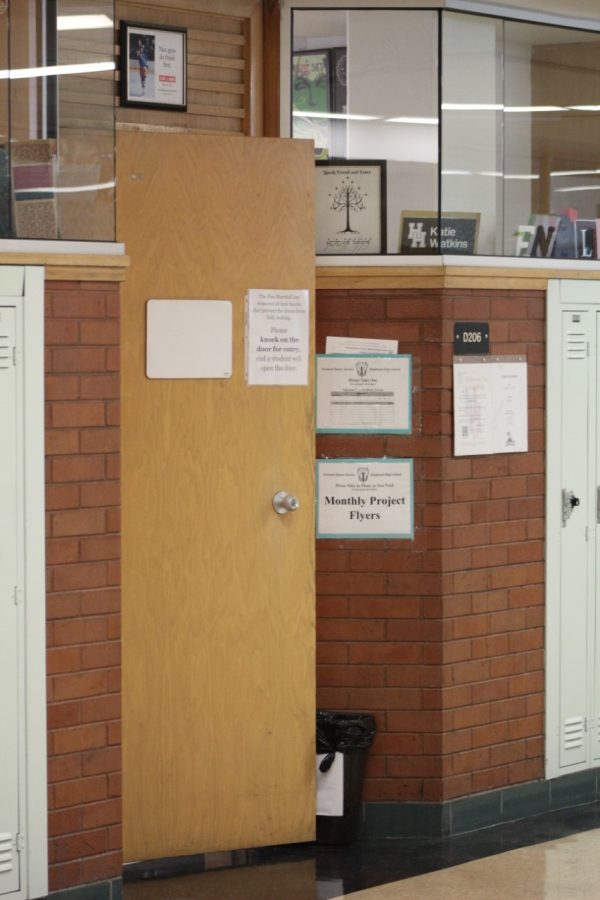Fire Marshal Announces Lock Blocks Violate Fire Code
A trash can holds open Highland teacher Katie Watkins’ door.
October 26, 2022
On October 24, two people were shot and killed in a St. Louis high school. The number of school shootings is approaching 40 in 2022 and is already more than any other year in American history.
By comparison, the National Fire Protection Association reports an average of one civilian death per year in school fires across the U.S.
For Highland teachers, it is easy to pick which threat should be dealt with first.
But on Friday, Oct. 21st, Highland’s principal relayed a message from the Utah State Fire Marshal that Lock Blocks, the little black levers that prop open classroom doors, were against fire code. This led to the immediate removal of all Lock Blocks around Highland, and a subsequent hit to the sense of safety felt by teachers and students.
With the upwards trend in the occurrence of school shootings in recent decades, safety devices like the Lock Block were developed to increase safety for teachers and students in class. The Lock Blocks allowed teachers to keep their doors locked throughout the day, while still allowing students access to the classroom.
In the event of an active threat, teachers could simply pull the lever to close the locked door; this is an alternative to having to go out into the hall and locking the door, possibly putting themselves and others in danger in the process.
For Highland teacher Sarah Lea, worrying about raging fires does not keep her up at night, but the threat of an active shooter is a constant concern.
“I would like to be able to, in under ten seconds, lock in my students when there is a threat,” said Lea. “And leaving my door unlocked – it cannot be locked in ten seconds.”
Many teachers were upset with the announcement. Highland history teacher Matthew Shake expressed frustration with the suddenness of the announcement.
“We were told on a Friday midday, and they were gone by Friday after school,” Shake said. “I felt like this decision was just handed down to us very suddenly.”
Utah State Fire Marshal Ted Black notified the district that the Lock Blocks needed to be removed due to the Utah state fire code that disallows doors designed to stop the spread of a fire from being propped open. The doors at Highland are such doors.
“[A fire-rated door] does two things: it prevents the fire from traveling into the corridor, and it prevents it from traveling into the room,” Black said.
If a fire were to break out in a classroom, and the Lock Block were to be left propping the door open, that door would no longer be able to contain the hot, expanding gasses and the fire would likely spread to the hallway.
“I’ve looked at it strictly from a fire code, fire-prevention viewpoint,” Black said. “And there’s nothing in any of our codes that would allow you to hold the door open in a manner similar to what the Lock Block does in a rated corridor.”
Black understands the inconvenience to teachers, but stresses that he and his coworkers are “strictly firefolk” doing their jobs to keep students and faculty safe from fires. He acknowledges that removing the Lock Blocks does create an additional security concern in schools.
“I’m sensitive to this [the issue of security]; this is the reason I’ve gone back clear through all the codes,” Black said. “It’s very clear that if the doors are in a rated corridor, they’re intended to latch. That’s what the law says.”
Shortly after the removal of Lock Blocks from district schools, the Salt Lake City School District ordered new hardware (locks) for each school. Over half a million dollars was spent on the new hardware that will allow doors to be locked from the inside of a classroom with a key.
However, the time between the removal of the Lock Blocks and when the new locks will be installed is still undetermined.
Highland Principal Jeremy Chatterton guesses that installation will take place around the end of the year.
“What we were told is that they’re hoping to have everything installed by the end of the year.” Said Chatterton.
While the response to the removal of Lock Blocks was rapid, the solutions that were found could cause further issues down the line. The amount of money spent on the new hardware is surprising on its own, but is even more significant considering that the district is looking at the feasibility of rebuilding both Highland and West in the next few years.
“I don’t think the district had intentions of spending all this money on new hardware until we were told we had to remove all the other precautions that teachers had.” Said Chatterton.
Even though the district has taken steps to replace the Lock Blocks, many teachers feel that the order of events is backwards
“Right now we don’t have any different solutions,” said Chatterton “because again, for fire code, we are not allowed to have anything on the doors that will change the composite of what the door’s supposed to do.”
As for Lea, she is confident that the Lock Blocks would not inhibit fire safety.
“We know from our training that when we leave for a fire drill, we must shut our doors,” Lea said. “I do that every time we have a fire drill…because we know what the rules are and what the policy is.”
“They shouldn’t have taken the lock blocks out until they gave us an alternative solution.” Said Shake.
Shake says that Highland goes through a fire safety inspection every year, but the Lock Blocks were never an issue until just now.
“They just took the Lock Blocks out with no alternative solution, except for my recycling can,” Shake said. “It’s become my door stopper now.”





























